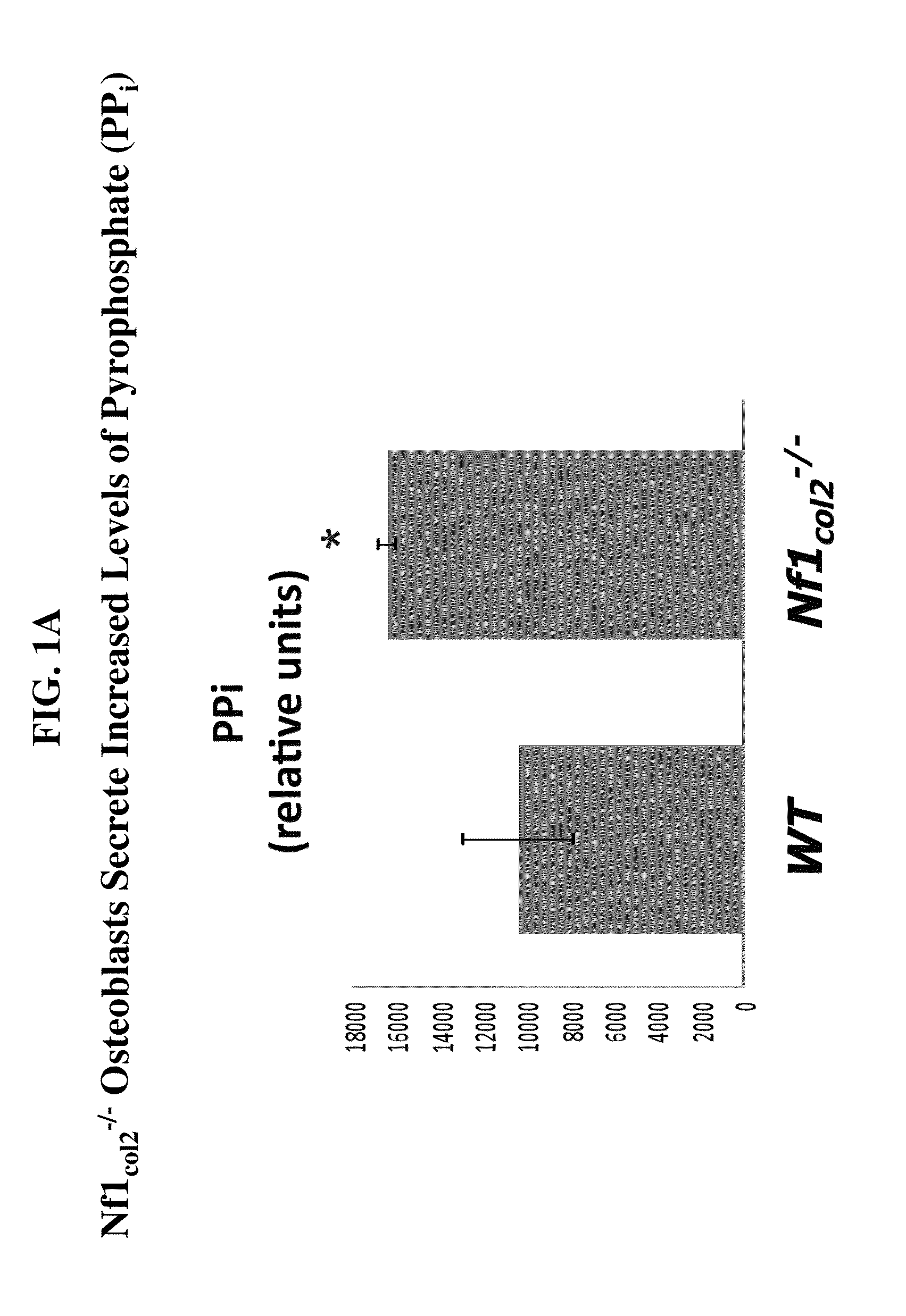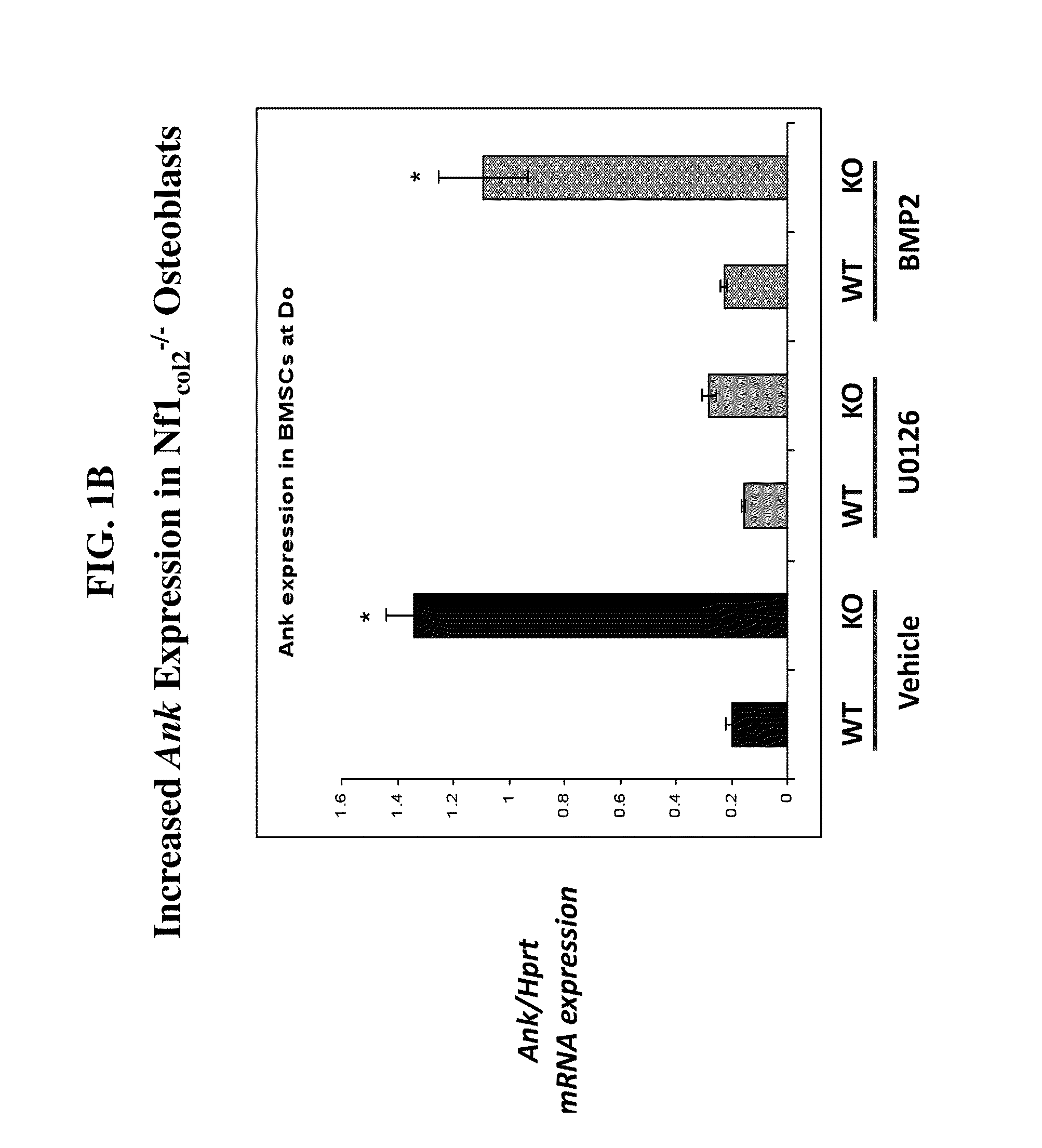Compositions comprising alkaline phosphatase and/or natriuretic peptide and methods of use thereof
a technology of natriuretic peptide and alkaline phosphatase, which is applied in the direction of peptide/protein ingredients, antibody medical ingredients, peptide sources, etc., can solve the problems of unsatisfactory treatment options, abnormal cell growth and differentiation, and inability to infusion native alkaline phosphatase, etc., to achieve dose-dependent side effects reduced
- Summary
- Abstract
- Description
- Claims
- Application Information
AI Technical Summary
Benefits of technology
Problems solved by technology
Method used
Image
Examples
example 1
Characterization of Osteoblasts in Mice Lacking NF1
[0380]To determine the effect of NF1 on bone matrix mineralization, mice lacking NF1 in osteochondroprogenitor cells were developed and characterized. These mice displayed skeletal dysplasia defects similar to patients with neurofibromatosis type I, where these defects included progressive scoliosis and kyphosis, tibial bowing and abnormalities in skull and anterior chest wall formation. In particular, NF1col2− / − osteoblasts secreted increased levels of (PPi) as compared to osteoblasts from wild-type mice (FIG. 1A). Bone marrow adherent stromal cells (BMSCs) extracted from adult NF1col2− / − mice and grown in vitro under osteogenic medium form less alkaline phosphatase (AP)-positive and less mineralized (alizarin red-positive) nodules compared to BMSCs extracted from wild-type mice, which is accompanied by an increased amount of PPi released in the medium over 24 hours. Accumulation of PPi prevents proper bone matrix mineralization an...
example 2
Combination Therapy for the Treatment of Neurofibromatosis
[0383]FIG. 2 provides a hypothetical working model for defective bone matrix mineralization in NF1col2− / − mice, which can include multiple imbalances (e.g., increase of PPi or overactivation of one or more kinases, such as Ras or ERK) that contribute to the disease. Without wishing to be limited by theory, accumulation of PPi could be minimized by using any of the compositions and methods described herein including a soluble alkaline phosphatase (sALP) or sALP analog (see, e.g., the polypeptide of SEQ ID NO: 1204). Furthermore, overactivation of one or more kinases could be controlled by using any of the compositions and methods described herein including an NP or NP analog. As described herein, the intracellular production of cGMP resulting from NPR-B activation is known to inhibit the MAP-kinase pathway. Thus, an NP or NP analog that could activate the NPR-B signaling pathway can be used for the treatment of neurocutaneous ...
example 3
In Vitro and In Vivo Effects of sTNALP-FcD10 on NF1col2− / − Phenotype
[0384]To assess the effect of sALP polypeptides on NF1 phenotype, cultures of osteoblasts from NF1col2− / − mice were treated with either bone morphogenetic protein 2 (BMP2) or the sALP fusion polypeptide of sTNALP-FcD10 (SEQ ID NO: 1204).
[0385]Both wild-type and NF1col2− / − osteoblasts were treated with increasing concentrations of recombinant human BMP2 (rhBMP2, FIG. 3A). In NF1col2− / − osteoblasts, rhBMP2 rescued the differentiation defect, as evidenced by an increased presence of alkaline phosphatase upon increasing doses of rhBMP2 (FIG. 3A, second row). However, increased mineralization was not observed, as evidenced by the lack of calcium deposition (as indicated by the lack of alizarin red S staining) (FIG. 3A, fourth row).
[0386]In contrast, treatment with sTNALP-FcD10 rescued the mineralization defect that is present in NF1col2− / − osteoblasts (FIG. 3B). Increasing doses of sTNALP-FcD10 provided increased calcifi...
PUM
| Property | Measurement | Unit |
|---|---|---|
| temperatures | aaaaa | aaaaa |
| temperatures | aaaaa | aaaaa |
| temperatures | aaaaa | aaaaa |
Abstract
Description
Claims
Application Information
 Login to View More
Login to View More - R&D
- Intellectual Property
- Life Sciences
- Materials
- Tech Scout
- Unparalleled Data Quality
- Higher Quality Content
- 60% Fewer Hallucinations
Browse by: Latest US Patents, China's latest patents, Technical Efficacy Thesaurus, Application Domain, Technology Topic, Popular Technical Reports.
© 2025 PatSnap. All rights reserved.Legal|Privacy policy|Modern Slavery Act Transparency Statement|Sitemap|About US| Contact US: help@patsnap.com



